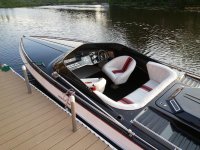ontherocks83
Active member
Alright I want to start off again by mentioning that I have been sailing for 25 years and owned a jet ski for 10 but this is my first year ever owning a pointy go fast boat. Ok maybe mine isn't all that fast but compared to my sail boat its a rocket. So please bear with me on some of my questions
So I have a 1989 Strobe 201 with a 350 magnum. I currently top out at about 55-57 mph at 4500 rpm. If I trim up any further it starts to chine walk and the label on the engine says max rpm is 4500 so I figure it is propped correctly and that is about the best I will get out of her. The prop is stainless and damaged (purchased that way) so I am hoping / hypothesising that once I get the prop rebuilt I might get 60 out of it or atleast a small increase in speed.
I see alot of boats on here that are a similar length that get 80+ mph. Some in the 70's and some over 100. I believe most are outboards but I could be wrong. I know outboards tend to have a better top end in general and no I am not expecting to ever get my boat that fast.
My question is: How stable are some of these smaller boats at those speeds? Does the water have to be mirror smooth to run like that? How do those smaller boats that run so fast handle at 50 mph in rougher waters? What is the benefit of having my boat with an I/O? Is mine more stable in rough waters or is it just a slower boat?
Basically besides top speed What are the big differences between my boat and some of these crazy fast boats (under 25 feet). Is it interior room, towing, stability in rough waters?
Is it comparable to a mustang vs a sport bike where the mustang is fast enough, can hold 5 people and still be used safely in the rain, where the sport bike is blindingly fast but if the conditions arent perfect then they dont go out. Or is it they just have better mustangs?
Thanks all

So I have a 1989 Strobe 201 with a 350 magnum. I currently top out at about 55-57 mph at 4500 rpm. If I trim up any further it starts to chine walk and the label on the engine says max rpm is 4500 so I figure it is propped correctly and that is about the best I will get out of her. The prop is stainless and damaged (purchased that way) so I am hoping / hypothesising that once I get the prop rebuilt I might get 60 out of it or atleast a small increase in speed.
I see alot of boats on here that are a similar length that get 80+ mph. Some in the 70's and some over 100. I believe most are outboards but I could be wrong. I know outboards tend to have a better top end in general and no I am not expecting to ever get my boat that fast.
My question is: How stable are some of these smaller boats at those speeds? Does the water have to be mirror smooth to run like that? How do those smaller boats that run so fast handle at 50 mph in rougher waters? What is the benefit of having my boat with an I/O? Is mine more stable in rough waters or is it just a slower boat?
Basically besides top speed What are the big differences between my boat and some of these crazy fast boats (under 25 feet). Is it interior room, towing, stability in rough waters?
Is it comparable to a mustang vs a sport bike where the mustang is fast enough, can hold 5 people and still be used safely in the rain, where the sport bike is blindingly fast but if the conditions arent perfect then they dont go out. Or is it they just have better mustangs?
Thanks all


